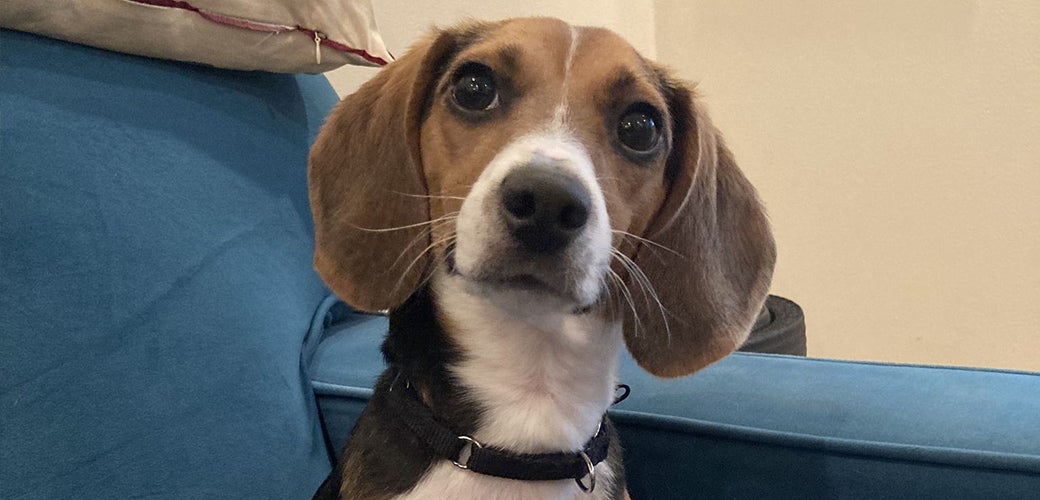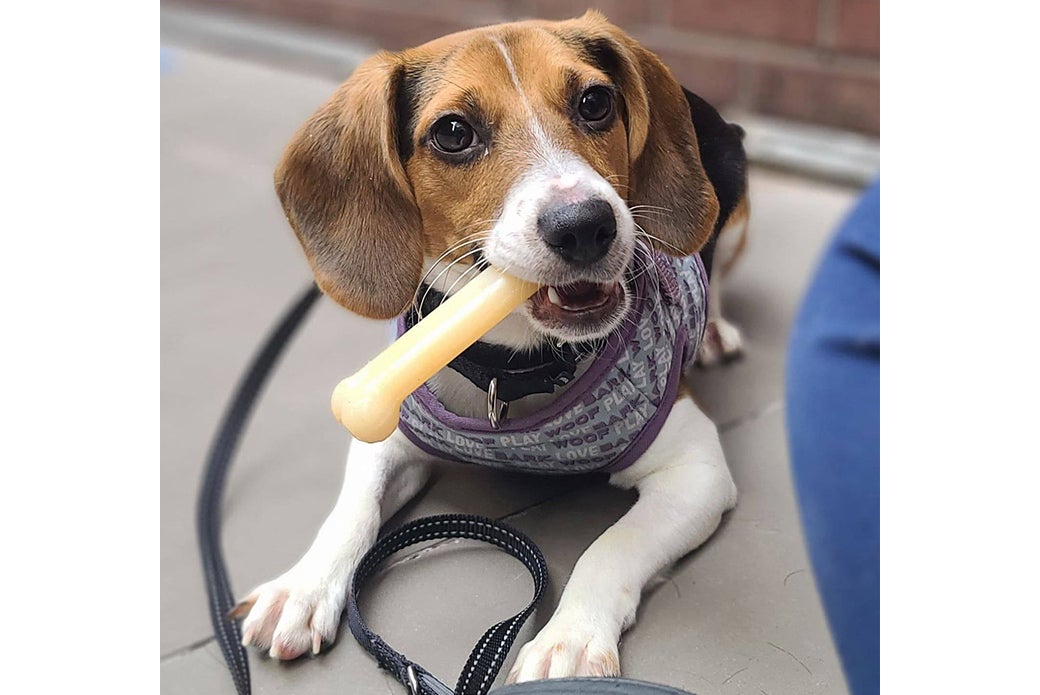

In their 37 years together, Robert and his wife, Karin, have always enjoyed the comfort and companionship of dogs.
“Our first was Calvin; he was our child,” says Robert. After Calvin, the couple adopted two beagles named Rudy and Archie, whom they had for 13 years. Archie and Rudy died in 2017—six months apart. The couple then adopted a mixed breed named Walter.
In July 2021, their daughter Pam, who had adopted a formerly abused beagle named Reggie, showed her parents an online photo of another abused beagle named Beeps who needed a home.


Motivated by the behavioral progress of Pam’s dog, Robert and Karin decided to consider Beeps.
“Reggie was initially very tentative and scared, not to mention thin and beaten up,” says Robert. “He was fearful and didn’t know how to be loved.
But we saw what it was like for an abused animal to receive love, and it was pretty amazing.”
They took on Beeps as a foster, and within a day, they knew they wanted to adopt her.
Learning to Walk Again
Beeps was brought to the ASPCA by the NYPD in October 2020. She had lost the use of her hind legs due to multiple fractures of her legs and pelvis.
“Her fractures occurred at different times and were never treated, so her bones did not heal correctly, which greatly limited her mobility,” says Dr. Aubrey Crowley, Medical Supervisor at the ASPCA Animal Recovery Center (ARC), who oversaw Beeps’ care.


Circles on X-rays indicate Beeps’ multiple fractures. Dr. J’mai Gayle restored mobility in Beeps’ right hip (blue circle) by removing pieces of her fractured femur, as well as realigning her right kneecap.
Beeps’ previous owner was arrested and pled guilty, and sentencing is pending in criminal court.
Dr. J’mai Gayle, Director of Surgery at the ASPCA Animal Hospital, did not attempt to repair any of the fractures because they were too old. But she did perform a femoral head osteotomy, or FHO, to surgically remove the pieces of Beeps’ right fractured femur, which helped restore mobility in her right hip. Dr. Gayle also surgically realigned Beeps’ right kneecap, or patella, which was dislocated.
“Beeps had old fractures on her left and right distal femurs—the area of the leg just above the knee joint—and fractures of both tibias,” says Dr. Gayle. “This was such a horrible case, so many fractures.”
In December, Beeps was referred to Manhattan’s Animal Medical Center (AMC), an ASPCA partner hospital, for rehabilitation therapy under the care of Dr. Leilani Alvarez, Director of Integrative and Rehabilitative Medicine.
Dr. Alvarez evaluated Beeps and designed a plan that featured advanced rehabilitation sessions matched specifically to her challenges. The therapy included a combination of extra-corporal shock wave therapy—or sound wave energy—and manual therapies like massage, stretching and a customized home exercise program.
“The shock wave therapy has the same energy of an ultrasound and utilizes sound therapeutically,” explains Dr. Alvarez. “It’s a high energy, high-velocity sound wave, low in frequency, that increased the elasticity of Beeps’ tissues and prompted blood flow to her leg, which had a severely restricted range of motion.”


Beeps also received four walks a day with a harness that supported her pelvis and lifted her hind legs off the floor.
“The rehab helped manage Beeps’ pain and improve her muscle strength, as well as flexibility and function of her limbs,” says Dr. Alvarez, who routinely treats patients unable to walk due to natural conditions, like herniated discs, as well as trauma. “At the same time, we try to rehabilitate them mentally and address their pain, so they begin to have positive associations with people and touch.”
Dr. Crowley fostered Beeps from early February to July 9, applying Dr. Alvarez’s schedule of rehab therapy at the ASPCA and at her home.


Beeps spent five months in foster care with Dr. Aubrey Crowley and her pets, center.
“Our veterinary staff attended virtual training sessions and appointments with the AMC rehab team to learn all the exercises Beeps needed for her recovery,” says Dr. Crowley. “We also recorded them on video. The nurses made it such a positive experience that Beeps was always eager for therapy, and it made her recovery that much better.”
Finding Beeps a Home
In addition to being physically traumatized, Beeps was shy and fearful when she arrived at the ASPCA. The ARC Medical and Behavior teams made the joint decision to seek placement for Beeps with a rescue group outside of NYC, according to Dr. Danielle Armato, a Medical Supervisor on the ARC team.
Coincidentally during this time, Dr. Crowley’s mother, Marion, struck up a conversation with Rebecca C., a foster caregiver who was walking two beagles at a Connecticut dog park for the Beagle Freedom Project (BFP), a non-profit known for rescuing and rehoming animals used in experimental research. Marion told Rebecca that her daughter was fostering a beagle and passed Rebecca’s information on to Dr. Crowley.


Dr. Aubrey Crowley and Beeps outside the ASPCA, left, and at her home.
Brian Fitzpatrick, Placement and Transport Manager for the ASPCA Humane Law Enforcement team, contacted Rebecca to coordinate Beeps’ placement with BFP, which is now among the dozens of ASPCA placement partners in 48 states.
According to Katherine Good, Senior Manager of Foster Care and Placement, 90 dogs and 12 cats from the ASPCA— including Beeps—were placed with shelter or rescue partners in 2020.
Winnie’s New World
Robert and Karin renamed Beeps “Winnie”—short for Winifred Daisy.
“We spend a lot of time with her,” Robert says. “It’s been a team effort between Karin and me.”


Beeps, now Winnie, with Karin, left, and Walter, right.
Walter has also taken on the role of Winnie’s big brother.
“Walter was not initially thrilled with Winnie, but they couldn’t be more connected at this point,” says Robert. “He’s 40 lbs. to Winnie’s 15, but he’s so gentle with her. It’s a real delight. They play all the time.”




Winnie relaxes with Robert and Walter.
Robert has videos of Winnie chasing Walter on their property in the Berkshires and playing tug-of-war with a rope toy.
“Knowing where she started, and where she is now —she’s a different dog,” says Dr. Crowley. “Seeing her with a loving family is one of those wonderful things that carries me through when my job gets tough. It makes me happier than words can express.”
“It’s such a reward to see her in a happy home,” says Dr. Alvarez.




“The lengths everyone went through for this sweetie makes us appreciate her and feel responsible for her even more,” says Robert. “Winnie is the happiest dog in the world, and we are so happy to have her.”
Source: Read Full Article



